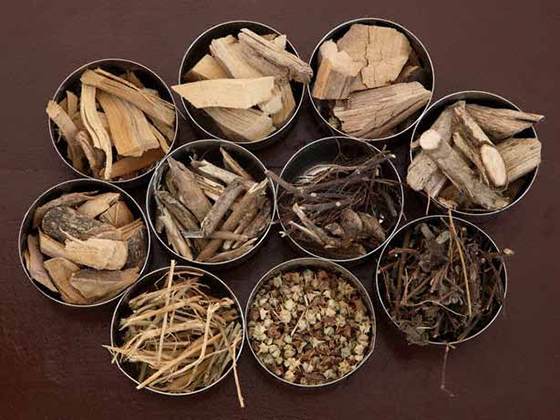Easy Muktayis Their Utilization in Kalpana Swara
Pancha Kashaya Kalpana
Method of Preparation, Dose and Comparison
Introduction
Ayurveda is the science which literally ways 'the science of life'. Information technology is also known as Indian system of medicine. Ayurveda is an ancient medical arrangement, which treats what is advantageous and what is harmful for the body and stresses on happy and unhappy states of life. In other words, Ayurvedic system of medicine gives importance to the involvement of the patient'southward well beingness.
Ayurvedic Chemist's shop
Ayurvedic Pharmacy is a Vast subject. Drug formulation in Ayurveda is based on following Seven Parameters:
- Dravya (Substance)
- Rasa (Taste)
- Guna (Property)
- Virya (Authorisation)
- Vipaka (Post-digestion outcome)
- Prabhva (Specific action)
- Karma (Pharmacological activity)
Ravya is described as a substance used for medicinal purpose. According to Ayurvedic theory, every component of the universe is dravya and has medicinal value. Charaka Samhita has described dravya to exist the nucleus of Ayurvedic chemist's.
Taste has a significant place in Ayurvedic medicine. Diagnosis of a disease is based on 3 biological humours (vata, pitta, and kapha) and handling is based on half-dozen tastes (sweet, sour, salt, pungent, biting and severe). Our tongue experiences these tastes when the drug is administered orally.
Guna is a vast topic. Ayurveda has described forty-i properties, which are comparable to physical backdrop of the drugs. Each property description has a specific role to play in the Ayurvedic drug formulation.
Virya (authorization) is described every bit the active elective of the drug and is responsible for the pharmacological activity of the drug. The drugs accept cold and hot potencies.
Vipaka and prabhava parameters are comparable with metabolism and specific action of the drug.
Karma parameter describes the pharmacological activeness of a drug in particular.
Ayurvedic Pharmacopoeial Preparations
Ayurvedic pharmacopoeial preparations are known as Panchakashaya kalpana. It is topic of Bhaishajya Kalpana, a total-fledged subject of Ayurvedic curriculum.
Panchakashaya Kalpana Includes:
- Swarasa
- Kwatha
- Phanta
- Shita
- Churna

Chief Ayurvedic Pharmacopoeial Preparations are Discussed Beneath:
Decoction
Decoction is the procedure of boiling in water coarsely comminuted vegetable drugs for a definite catamenia.
Before preparing decoction the drug should exist sliced before information technology is boiled in h2o for 5 minutes or longer. If the comminution is likewise fine some sediment deposits.
Afterwards preparing decoction it should exist stored in sterile bottles. Earlier pouring into bottles, the decoction should be strained instead of filtering.
The decoction should be discarded if modify in colour is at that place or pocket-sized white blobs announced on the surface.
Medicinally, decoctions are used externally for washing wounds and internally for curing aliments.
Decoctions are therapeutically more active as it vigorously extracts the virtues of medicinal plants, roots, twigs, barks and seeds.
Dose is 15-30 ml with h2o.
Infusion
Infusion is comparable to a cup of tea.
Boling or cold distilled water is poured on the drugs in a covered vessel and kept for fifteen minutes and then strained.
Sometimes boiling is done for hours to ready potent infusion.
Hot infusion is stronger than common cold as information technology extracts the active principle more effectively. Every drug has fixed time during which it imparts its belongings to h2o.
For preparing cold infusion boiling water is non required. Coarsely powered drug is kept in a airtight vessel containing h2o for twenty–iv waters. The powdered drug imbibes some liquid and a mass is formed. The mass is pressed to obtain liquid, which is nerveless in a measuring flask and mixed with water left in vessel and quantity is measured.
The infusions should be used within twelve hours until preservative has been added.
Sometimes infusions are prepared with weak alcohol which acts as preservative.
Shelf-life of booze based infusions has not been adamant simply it has reward over water based infusions.
Water used in preparing infusions should be distilled. Hard water should not be used equally compatible color is not obtained and it is non able to excerpt all the virtues of medicinal herbs.
Dose is 30-60 ml with water.
Powders
Powders are mixtures of dry substances reduced to fine powder and intimately mixed together. In Ayurvedic system of medicine, powdered preparations are known every bit churna-kalpna.
Drug to be powdered is thoroughly washed with water and dried. Properly dried drug is reduced to powder in a pestle and mortar.
Powders may exist of a unmarried substance and more often of several (chemical compound powders). The different ingredients finely powdered separately and weighed to the required corporeality are advisedly mixed with a spatula on a slab or with a small pestle and mortar and made in to fine, nearly impalpable form.
Powders should exist mixed in a very articulate mortar. The method of mixing greatly affects the miscibility of powders.
A powerful constituent should be first triturated with some bland substance and so slowly mixed with the residual of the lot. It should be packed in white glazed newspaper.
Hygroscopic drugs should exist stocked in accurately plumbing fixtures glass stoppered phials and dispensed wrapped in waxed or paraffin newspaper and preferably covered with tin foil.
A powered drug is made to laissez passer through a sieve containing parallel wires closeness and powders of different fineness are produced
Past repeated sifting and shaking in a bottle the ingredients are thoroughly incorporated and a uniformity of color is obtained.
Dose of pulverisation is i-v G.
Source: https://www.planetayurveda.com/pancha-kashaya-kalpana/